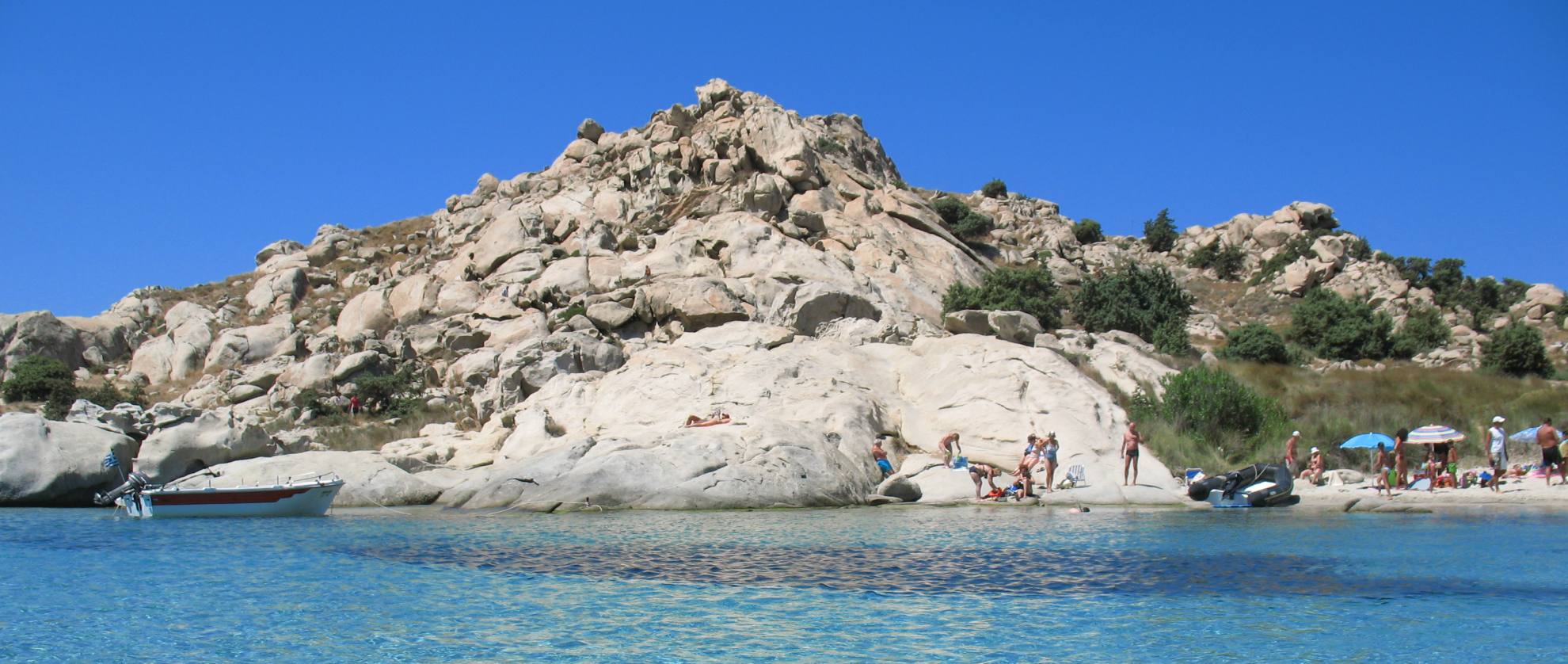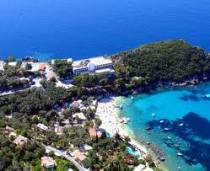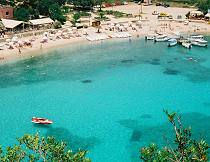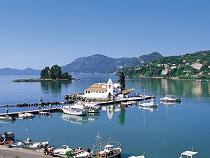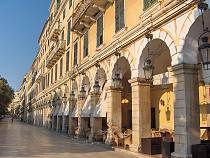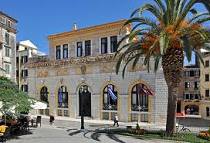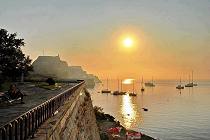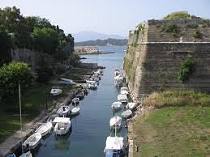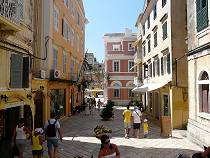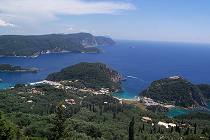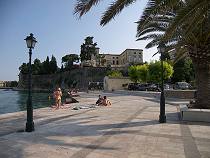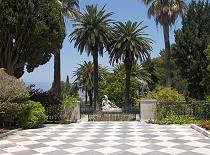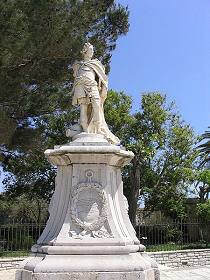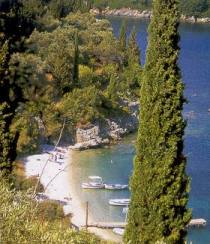Corfu (Kerkyra) - for all tastes and ages
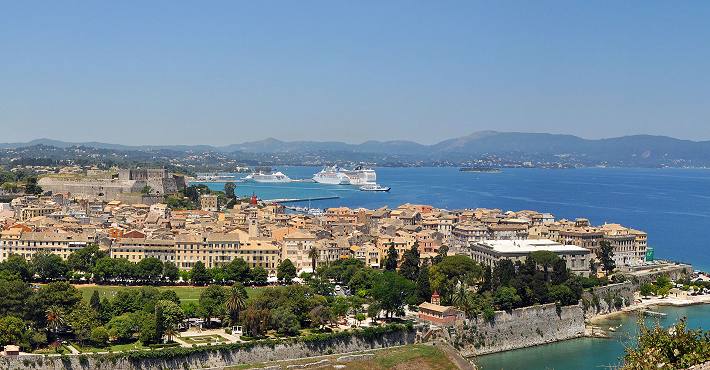
Said to be blessed by mother nature, Corfu (or Kerkyra in Greek) the magical island, boasts natural beauty blanketed with lush emerald green vegetation. Covered with olive trees, cypress, orange and lemon groves, mountains with steep cliffs fringe spans of golden sandy beaches, secluded coves and pebbly shorelines leading to clrystal clear waters.
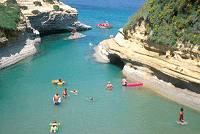 A rich blend of charm and character, Corfu offers all the contemporary comforts along with its natural attractions.
There is an excellent choice of vibrant beach resorts.
There are family oriented havens with ample bars and restaurants, to supplement traditional tavernas and peaceful
little villages.
location for relaxing and memorable holidays.
A rich blend of charm and character, Corfu offers all the contemporary comforts along with its natural attractions.
There is an excellent choice of vibrant beach resorts.
There are family oriented havens with ample bars and restaurants, to supplement traditional tavernas and peaceful
little villages.
location for relaxing and memorable holidays.
As an international tourist centre, Corfu can satisfy the demands of the most discerning visitor. Whatever type of vacation the visitor seeks, long lazy days in the sun, dancing through the night, sampling traditional Greek village life, or just relaxing and soaking up the ambience Corfu can offer it all.
-
Getting There
Ferries:
From Patras on Italy route (stopover Corfu)
For Sagiada, Thesprotia.
From Paxos Islands
From Igoumenitsa to Lefkimmi harbor and Corfu.
Buses:
From Athens: via Igoumenitsa (KTEL Athens, Kifissou 100 (11 hours) Tel: +30 210 5133583.
KTEL Corfu Tel: +30 26610 39985)
From Thessaloniki: (+30 2310 528600)
Air:
From Athens to Corfu, Olympic Airways & Aegian Airlines
From Thessaloniki to Corfu, Olympic Airways
Direct flights from many European cities -
Getting Around
KTEL
terminal Avramiou str., Corfu, (+30) 26610 39985, (+30) 26610 30627.
Daily service to
Afiona, Arilla, St. George Pagon, St. Gordio, St. Matheu, St. Stephan, Avliotes, Barmbati, Hermones, Glyfada, Kassiopi, Kavo, Korakiana, Liapades, Loutses, Messogi, Palaiokastritsa, Pyrgi-Ypso, Roda - Acharavi, Sidari, Kassiopi, Spartera.
Urban Lines
terminal Saroko Squer Corfu, (+30) 26610 39859. Daily Service to Kanoni, Analipsis, Potamo, Temploni, Kastellanous, Kouramades, Perama - Benitses, Kontokali - Givia - Dasia, Afra, St John, Achilio - Gastouri.
Special interest holidays in Corfu
• Sailing - There are numerous yacht charter agencies in the area around the marina and also in the town of Corfu.
More info at Corfu Yachting, Tel: +30 26610 99470
• Scuba diving - Corfu is at the forefront of all underwater activities.
The island's coastline and bays, its headlands and reefs make a paradise for diving fans.
More info at Seven Islands Dive Center, Tel: +30 26610 90006
• Walking - Stroll along cobbled footpaths, some dating
from Byzantine times, and across
hillsides scented with wild flowers.
Meander along picturesque coastlines,
beside water of dazzling clarity.
Discover a landscape of olive and cypress groves,
plains of grass with vineyards and orchards.
• Cycling - More than 6000 people come to Corfu just to cycle.
More info at Mountain Bike, Tel: +30 26610 93344
• Horse riding - Corfu is one of the greenest and lushest Greek Islands making it a heaven
for horse riding. More info at Trailriders, Tel: +30 26630 22503
• Cricket and Golfing - Cricket has been palying on Corfu Town's "Esplanade", since the British introduced the sport in the 19th century.
The 18-hole Corfu Golf is located in Ropa valley, 18 kilometres from Corfu Town.
• Religious tourism - An important number of visitors are attracted to visit Corfu by the island's many
Greek Orthodox churches and other monuments of religious interest.
• Wedding in Corfu - Corfu offers an ideal setting for the most important moments of a person's life.
It is a cosmopolitan resort for the last two centuries, it fires the imagination and sets the scene for the enjoyment
of those unique first days together as a newly wed couple.
Enents is a celebrations and events organiser and party planners company. Tel: +30 22610 32245
• Gastronomy - To present a table laid with food in Corfu is a major concern.
The right food for the right season.
Corfu Beaches
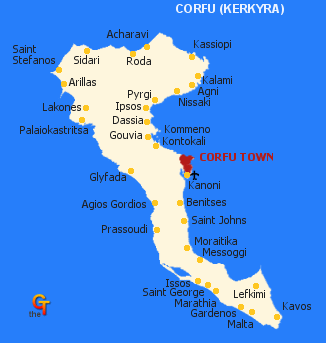 Acharavi, beautiful, long sandy and shingle, gently-shelving, beach.
Acharavi, beautiful, long sandy and shingle, gently-shelving, beach.
Arilas, one kilometre of fine golden sand. Watersports are available.
Dassia, sand and shingle beach backed by forests and olive trees. Watersports are available.
Gardenos, superior sandy beach.
Gouvia, nice sand and pebble beaches with watersports.
Ipsos, pebble, shingle beach with watersports.
Kalami, pebble beach with clear waters. Watersports are available.
Kassiopi, numerous pebble and shingle bays.
Kavos, long and sandy, shallow water with watersports.
Krouzeri, beautiful, long pebble beach.
Malta, excellent sandy beach.
Gouvia, nice sand and pebble beaches with watersports.
Saint George, sandy beach.
Saint Stefanos, long stretch of gently shelving golden sand, with watersports.
Sidari, long, sandy and gently shelving beach with watersports.
Places to visit
Old Fortress:
This was built by the Venetians upon the remains of a Byzantine casde
and was completed in two stages. During the first period (1400-1500)
the Venetians strengthened the Byzantine walls and dug the Contra Fossa moat,
turning the promontory into an artificial island accessed by a
movable bridge. In more recent times the Contra Fossa became notorious
as the classic site of romantic suicides. The second period (16th-
18th centuries) began with the completion of this work (1546-1588)
and ended with the additions and alterations made by the British. Today
two impressive bastions remain. which bear the names of the Italian
engineers Martinengo and Savorgnan, as well as later British buildings
and accretions. such as the church of St.George, built in 1840 as a basilica
with Doric columns. Most of the churches and other buildings have
however been destroyed. most important amongst them the Palace of
the Venetian Proveditore.
New Fortress:
Built between 1572 and 1645 by the Italian architect F. Vitelli, on the hill of St. Mark, the inner buildings of
the fortress were constructed by the British. It consists of two massive twin bastions and is considered to be a
marvel of fortress architecture. It should be visited not least for the magnificent view of the town and sea that
it affords, preferably in the late afternoon, when the heat is less intense. Recendy restored, it is often used by
the municipal authorities of Corfu for exhibitions, concerts and many other cultural activities ( for full details
of the pro'gramme of events contact the Municipal Information Office).
There is a bar/cafe within the fortress,
and a "gallerie" where you may obtain various publications
issued by the municipality, prints, tourist guides and maps.
In the wing on the left-hand side of the first floor of the barracks
there is an exhibition centre, where interesting collections of
paintings, sculpture and photo-
graphs, by artists of international
repute, are often displayed. The
stairs you ascend in order to penetrate
into the Fortress lead to
one of the tunnels, which in turn
leads to the centre of the town
by way of the local market-place.
The area in which the market is
located was a "dry moat", over-
looked by ramparts and connect-
ed with the Fortress as part of its
fortifications.
Archeological Museum: - Tel: +30 26610 30680
Bronze statures from the Archaic to the Roman era. Funeral offerings from the Archaic, Classical and Hellenistic eras, from the cemeteries of Garitsa and Almyros, as well as a rich collection of ancient coins. Findings from the Prehistoric era and findings from the 7th and 6th century B.C. with the exceptional Menecrates lion, clay pottery and terracotta statuettes from the shrines of Corfu and the impressive Gorgon-Medusa pediment from the great temple of Artemis, made in 585 B.C., excavated in 1911 near the monastery of Aghioi Theodoroi, the oldest, so far, stone-pediment of an ancient Greek temple.
In other halls of the Museum there is another impressive limestone pediment (500 B.C.) from a Dionysos temple at Figaretto, 13 identical terracotta statutes of Artemis, exhibits from the 4th century B.C. to the Roman period, and the marble heads of the poet Menander and historian Thucydides. Finally there are exhibits from Paleopoli and Kassiopi, like: bronze surgical tools, clay oil-lamps and bone-tools of everyday use.
Byzantine Museum - Antivouniotissa Church - Tel: +30 26610 38313
The Byzantine Museum is housed in the Panagia Antivouniotissa Church. The church is dedicated to our Lady Virgin Mary Antivouniotissa (Antivouniotissa = opposite the mountains) and is one of the oldest and richest ecclesiastical monuments of the city. It was probably built at the end of the 15th century. It is a single nave, timber-roofed basilica that preserves in tact the particularity of the Corfiot-Septinsular Basilica type church of that era, that is, the existence of an exo-narthex that surrounds the church on three sides. There is an atrium on the eastern side, were a belfry is incorporated. The church internally is very impressive with high stalls, painted tapestries and a ceiling adorned with gilt coffers framing relief floral decorations. The templum and the floor of the church are made of stone. On the narthex there are gravestones with carved names and coats of arms of noble families, high priests and other prominent members of the Corfiot society.
In the Museum there are about ninety portable icons and soon the Museum will be completed with the exhibition of the archival material of the church. The exhibited icons date from the second half of the 15th century until the 19th century and are indicative of the role that Corfu played in the development of the Greek ecclesiastic iconography, especially after 1664, when many refugees Cretan painters arrived in Corfu either to settle, or on their way to Venice.
The visitor may see the icon of Virgin Hodegetria of Castelani, of the second half of the 15th century, from a Macedonian workshop, as well as the Saints Sergius, Bacchus and Justine, a work for the church of Trimartyros made after the battle of Lepanto (1571) by Michael Damaskinos. There are also the icons of the Epitaph, by Emmanuel Tzanfournaris, the small icon of the three Archangels, of the first half of the 17th century, by George Cortezas, the icons of Emmanuel Lambardos and Jeremias Palladas, painters that are distinguished for their exceptional technique and their conservative attitude, and finally the Dodecaorton icons of Emmanuel Tzanes, his icon "Noli me tangere", an order by the Justiniani family in 1657, and individual works by the painters Angelos, Andreas Ritzos, Ioannes Moschos, Theodoros Poulakis, Victor, Emmanuel Skordilis, Stefanos Tzankarolas and Constantinos Contarinis.
Museum of Banknotes - Tel: +30 26610 41552
The Museum of Banknotes, is unique in Greece and one of the few and most interesting worldwide and operates since 1981.
Municipal Gallery - Tel: +30 26610 44606
A large collection is exhibited with mainly donated works.
Among the most famous exhibits are: "The Assassination of Capodistrias" by Ch. Pachis, "Markas" and "Flock" by A. Giallinas, "The Sphinx" by Sp. Scarvelis, "Warrior of '21" by Sp. Prossalendis, "Arab Musician" by P. Prossalendis, "The Piano Tuner" by G. Samartzis, works that synopsize the basic trends of the modern Greek Art of the 19th century. The main trends that prevail on the works of the Corfiot artist of the 19th century, have to do with the Academic trends and also with the influence that the Italian painting had on the artists. During the end of the 19th century, the turn of the artists to the impressionistic movement will offer a different but decisive tone to the Corfiot artistic production.
Touring Corfu Island
Corfu (Kerkyra) Town
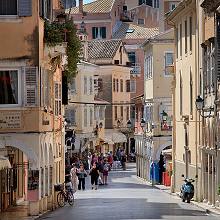 The capital of Corfu is the elegant Corfu Town.
Walking through Corfu Town is like browsing through a history book.
A Venetian architectural wonder of
narrow alleys -the "Kandounia", paved squares, impressive mansions and old multi-floored houses.
Add to this several museums, the island's Patron Saint Spyridon Church,
narrow streets full of atmosphere, great restaurants, bars,
plus a wealth of tempting shops and boutiques.
The capital of Corfu is the elegant Corfu Town.
Walking through Corfu Town is like browsing through a history book.
A Venetian architectural wonder of
narrow alleys -the "Kandounia", paved squares, impressive mansions and old multi-floored houses.
Add to this several museums, the island's Patron Saint Spyridon Church,
narrow streets full of atmosphere, great restaurants, bars,
plus a wealth of tempting shops and boutiques.
The Old Town is one of the most charming parts of the Corfiot capital and owes its peculiar architectural planning to the rules set by the Venetians for its defence. Built between the walls and the two Venetians Fortresses, the Old Town offers both resident and visitor the opportumty for romantic strolls in enchanting surroundings. Here, in the picturesque "maze of narrow streets (Kandouma), under the tall buildings and old churches, the present meets the past, and it seems that time stands still.
The charming housing blends harmoniously with
the impressive arcaded colonnades of the Liston
and the majestic 19th century Palace of St.
Michael & St. George, which border the largest
and most beautiful square in Greece:
The Esplanade. The architectural richness of the town continues in the pictoresque streets of the
busy commercial centre and also in more quiet neightbourhoods where among old mansion-
houses stand the present Town Hall (17th century), the Ionian Parliament ( 1852), and the old Goverment House (1840).
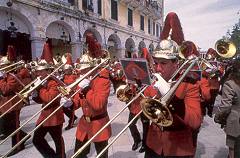 Most important amongst the many churches (mainly from the
16th to the 18th centuries) are the Metropolis
Church (16th century) and the Church of the
Patron Saint of Corfu St. Spiridon ( 16th century)
where, the holy relics of St. Theodora Augusta
and the island's holy protector are kept. The
most important town monuments are the
Maitland Rotonda ( 19th century) in the upper
square of the Esplanade, the burial monument
of Menecrates (circa 600 BC) in Garitsa and
the Byzantine church of St. Jason and St.
Sosipatros (circa 1000 AD) in Anemomylos as
well as the ruins of the early Basilica of
Paleopolis and the archaic temples in the
Kanoni peninsula. The local customs, the
processions; theatrical and especially musical
activities, the artistic festivals offer many
opportunities for recreation both in and out of
town, and complete the enchanting atmosphere
of the historical capital of Corfu.
Most important amongst the many churches (mainly from the
16th to the 18th centuries) are the Metropolis
Church (16th century) and the Church of the
Patron Saint of Corfu St. Spiridon ( 16th century)
where, the holy relics of St. Theodora Augusta
and the island's holy protector are kept. The
most important town monuments are the
Maitland Rotonda ( 19th century) in the upper
square of the Esplanade, the burial monument
of Menecrates (circa 600 BC) in Garitsa and
the Byzantine church of St. Jason and St.
Sosipatros (circa 1000 AD) in Anemomylos as
well as the ruins of the early Basilica of
Paleopolis and the archaic temples in the
Kanoni peninsula. The local customs, the
processions; theatrical and especially musical
activities, the artistic festivals offer many
opportunities for recreation both in and out of
town, and complete the enchanting atmosphere
of the historical capital of Corfu.
Acharavi
Stands on a long sandy shingle, gently-shelving, beach which
stretches between Kassiopi and Roda and is an ideal choice
for a relaxing beach holiday. There are a good choice of
tavernas and restaurants, bars to ensure an
enjoyable holiday, with this also being an ideal base for
exploring the rest of Corfu's dramatic northern coastline.
Benitses
The coastal region of Benitses, very developed as a tourist area, with hotels, tavernas, restaurants and nightclubs. Dense vegetation and beautiful beaches are typical of the area. It is said that the gardens of King Alkinoos were situated here. The springs providing waters to the Corfu Aqueduct are in the area, as are ruins of Roman baths with mosaic floors.
Dassia
Set alongside a long shingle beach, Dassia has grown over the
past few years into one of Corfu's most popular and
cosmopolitan resorts. It's great speciality is watersports and
parascending.
Dassia attracts a wide range of visitors with all types of accommodation from self catering to top class hotels. The gently shelving shingle and pebble beach slips into a long crescent bay.
Gouvia
Stretching from sea to coastal road and beyond, Gouvia has spread to meet neighbouring Kontokali.
Beautiful beaches are in the bay of Gouvia, with a well-developed tourist infrastructure.
The ruins of a Venetian naval station are to be seen here, dating from 1778.
Ipsos
A tourist resort. It has a sizeable and very attractive beach with facilities for all marine sports. With its imposing backdrop of Mount Pantokrator and its slopes covered with olive trees, Ipsos has a special charm of its own.
Kanoni
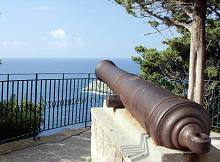 Kanoni took its name from the gun (kanoni in greek) emplacement established here in 1789 by the French on the site of the present day tourist pavilion.
Three miles from Corfu Town, Kanoni sits in a very pretty and residential corner. We cannot avoid saying that
it is also where Corfu airport is situated. This does not take away the area's many charms, including 'Mouse
Island' easily reached by boat, Vlakherna, housing a small convent and linked to Corfu by a narrow causeway,
plus Mon Repos Palace, birthplace of the Duke of Edinburgh.
Kanoni took its name from the gun (kanoni in greek) emplacement established here in 1789 by the French on the site of the present day tourist pavilion.
Three miles from Corfu Town, Kanoni sits in a very pretty and residential corner. We cannot avoid saying that
it is also where Corfu airport is situated. This does not take away the area's many charms, including 'Mouse
Island' easily reached by boat, Vlakherna, housing a small convent and linked to Corfu by a narrow causeway,
plus Mon Repos Palace, birthplace of the Duke of Edinburgh.
Kassiopi
Climbing the hillside behind a pretty harbour, Kassiopi is a popular town with a little port and main
square with restaurants and tavernas.
A number of narrow streets lead from the harbour to the town's beaches. Kassiopi is an ideal point of departure for visitors wishing to explore all the northern part of Corfu.
Shingle and pebble bays stretch out on either side of the harbour.
The town is built on the site of an ancient settlement. Kassiopi flourished during the Roman period, chiefly on account of its geographic position overlooking the sea pass. In ancient times there was a sanctuary to Zeus here, on the site now occupied by the 16th century Panagia Kassiopitissa. The ruins of the town's castle, dating from the 14th century, can be seen on the hill.
Kavos
At the southern tip of the island, and one of the largest
resorts, Kavos is truly Corfu's buzzing holiday hot spot.
Excellent beach, great restaurants whatever your tastes, loads
of watersports, bars and clubs.
Kontokali
This resort, famous for its pretty and attractive yacht marina is just 4 kilometres north of Corfu Town.
It has a gret selection of restaurants and tavernas and several bars to choose from. Kontokali has a couple of sand and shingle beaches.
Lakones
A typical Corfiot village on a green hillside. It is worth taking a walk to Bella Vista, where the visitor can lounge in one of the charming coffee shops and admire the view over the bay of Palaiokastritsa. If you like rambling outdoors you can follow the steep path which will take you to Palaiokastritsa village.
Lefkimi
A large market town near the sea, retaining many traditional features. Its vineyards produce the famed wine of Lefkimmi. Lefkimmi consists of five villages, which is why it is also known as the "pentihora". Rigalades, Anaplades, Agioi Thodoroi, Potami and Melikia. Chief among the town's sights is the small canal with the small bridge which passes through the centre of the town. Its narrow streets are lined with shops and workrooms. From here one can visit the monastery of "Our Lady of the Angels", which was founded in 1669, or the monastery of the "Panagia Arkoudila", dating from 1700.
Gardenos and Malta on west coast are excellent beaches and easily accessed from Lefkimi.
Moraitika
A seaside tourist resort situated at the mouth of the river Mesoggi. The area could well have been inhabited since Neolithic times if one is to judge from the small 3rd century B.C. temple which can be seen high up on the hill. At the river mouth there are ruins of a Hellenoromaic building.
Nissaki
The small settlement of Nissaki has a fine beach for swimming and relaxation and a wide choice of tavernas.
Lefkimi
A large market town near the sea, retaining many traditional features. Its vineyards produce the famed wine of Lefkimmi. Lefkimmi consists of five villages, which is why it is also known as the "pentihora". Rigalades, Anaplades, Agioi Thodoroi, Potami and Melikia. Chief among the town's sights is the small canal with the small bridge which passes through the centre of the town. Its narrow streets are lined with shops and workrooms. From here one can visit the monastery of "Our Lady of the Angels", which was founded in 1669, or the monastery of the "Panagia Arkoudila", dating from 1700.
Gardenos and Malta on west coast are excellent beaches and easily accessed from Lefkimi.
Nissaki
The small settlement of Nissaki has a fine beach for swimming and relaxation and a wide choice of tavernas.
Palaiokastritsa
Maybe the most picturesque spot in Corfu with amazing views everywhere you look.
There are four bays and taxi boats provide easy access to other ones.
There's a good sprinkle of tavernas and shops along the twisting road that leads to the village and even if there's
just one disco, you'll find that the majority of bars and tavernas have impromptu folklore shows at night.
The steep hills contribute to the splendid views.
The monastery of the Virgin was founded in 1225, though the building the visitor sees today dates only from the 18th-19th centuries. There is a museum with Byzantine and post-Byzantine icons. Legend has it that the small island of Kolovri at the entrance to the bay is a pirate ship which was turned to stone by the Virgin Mary, in this way protecting the monastery and the local population. Aggelokastro is the westernmost outpost of the Despotate of Epirus, to which Corfu belonged until 1267.
Roda
Roda as also nearby Acharavi on the northern part of the island, offer an ideal combination of sea and mountain, while there have also been many important archaeological finds in the area. The beach is one of the most beautiful on the island, while the traditional settlement of Ano Acharavi is distinguished for its architecture.
Saint George
The five kilometres of wonderful golden sands is a welcoming sight to sun-worshippers as well as to windsurfing,
waterskiing and paragliding enthusiasts. This lovely area on the south-west coast ranks as one of the few
uncommercialised spots on the island with a handful of tavernas and shops plus a couple of music bars.
Saint John
Saint John (or Agios Ioannis in Greek) offers the best of both worlds, quiet immediate surroundings and busy
neighbouring resorts.
The main sandy beach surrounds a horseshoe shaped bay with crystal clear waters, gently shelving.
Sidari
The most developed tourist area on the north side of the island.
Like nature's sculpture the sandy elevations in the sea form
a natural canal which is called the Canal of Love, or Canal d'Amour.
Sidari has an engaging combination of excellent amenities and a long, sandy and gently shelving beach. Watersports are available.
